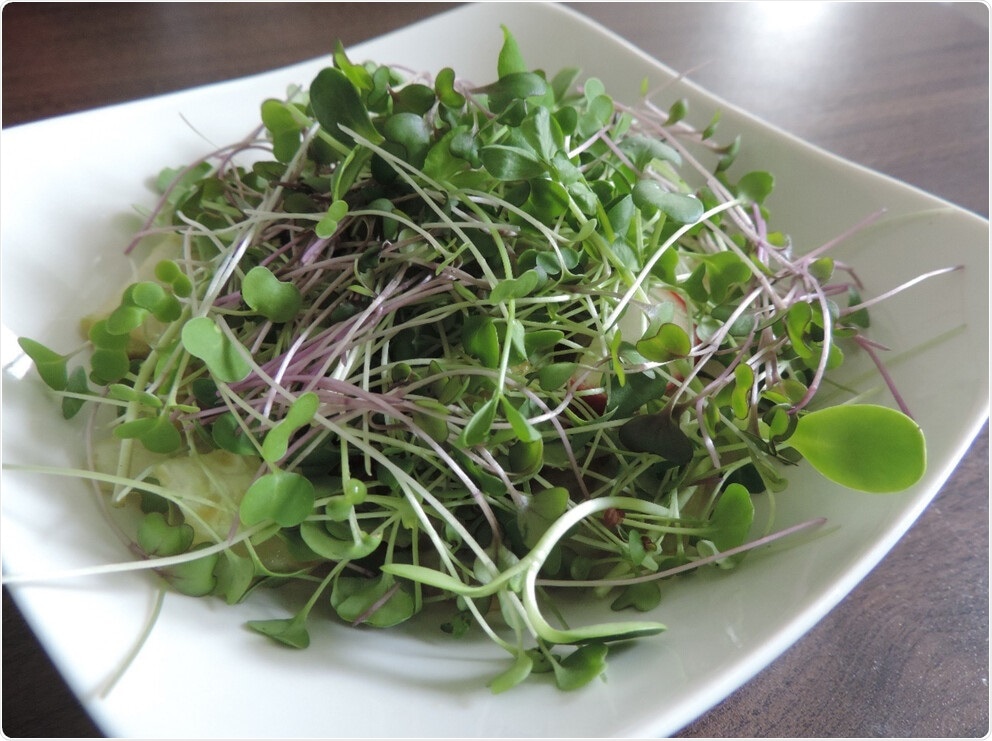Microgreens were grown years ago as high-value, fashionable gourmet greens. At present, microgreens have become familiar among consumers for their great content of antioxidants and nutritional profile. Recent research indicates that these tiny plants possess the capability to offer global nutrition security.

A salad with a mix of microgreens freshly harvested from a kitchen “garden.” Consumers can produce microgreens at home using simple tools available in a kitchen. Image Credit: Francesco Di Gioia/Penn State.
A group of international scientists identified that the vegetables can be grown in various soilless production systems in limited spaces indoors, in the presence or absence of artificial lighting. The observations are particularly appropriate amidst pandemic-disrupted food supply chains. The project was titled, “Food Resilience in the Face of Catastrophic Global Events.”
As stated by team leader Francesco Di Gioia, assistant professor of vegetable crop science, College of Agricultural Sciences, Penn State, with microgreens, individuals can produce fresh and nutritious vegetables even in regions that are regarded as food deserts.
“The current COVID-19 pandemic revealed the vulnerability of our food system and the need to address malnutrition issues and nutrition-security inequality, which could be exacerbated by potential future emergencies or catastrophes. Nutrient-dense microgreens have great potential as an efficient food-resilience resource.”
Francesco Di Gioia, Assistant Professor, Vegetable Crop Science, College of Agricultural Sciences, The Pennsylvania State University
The nutritional profile of microgreens is linked to the wide variety of shapes, colors, textural properties, and flavors acquired from sprouting a multitude of edible vegetable species, which includes herbs, herbaceous crops, and wild edible species.
According to Di Gioia, the small growth cycle of the microgreens demanding only very little inputs of fertilizer has excellent potential to offer vital nutrients and antioxidants. Employing simple agronomic techniques, it is possible to produce micro vegetables that can handle distinct dietary needs or micronutrient deficiencies, along with nutrition-security problems in emergencies or in demanding environmental conditions.
Di Gioia says people can grow their microgreens at home with simple tools from the kitchen. A consumer will also need growing trays, growth medium, and seeds. The growth medium would mostly contain common peat or peat and perlite growth mix.
Scientists at NASA and the European Space Agency suggested microgreens (owing to their characteristics) as a source of fresh food and vital nutrients for astronauts involved in long-term space missions.
Di Gioia proposes the preparation and storage of microgreen production kits including seeds and to make them available on-demand, as microgreens can be used as a functional food to increase nutrition security under the present circumstances and during future catastrophes or emergencies.
Under such circumstances, a variety of fresh and nutrient-rich microgreens could be grown providing a source of minerals, vitamins, and antioxidants in a relatively short time. Or alternatively, kits could be distributed to vulnerable segments of the population as a short-term nutrition-security resource.”
Francesco Di Gioia, Assistant Professor, Vegetable Crop Science, College of Agricultural Sciences, The Pennsylvania State University
The study was published in Acta Horticulturae, a journal of the International Society for Horticultural Science. Di Gioia presented the research virtually during the International Symposium on Soilless Culture and Hydroponics sponsored by the International Society for Horticultural Science last spring. The symposium was scheduled to be conducted in Lemesos, Cyprus, but due to the growing COVID concerns, it was held online.
Source:
Journal reference:
Di Gioia, F., et al. (2021) Microgreens: from trendy vegetables to functional food and potential nutrition security resource. Acta Horticulturae. doi.org/10.17660/ActaHortic.2021.1321.31.